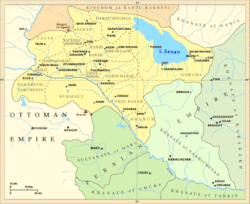| Revision as of 19:04, 31 May 2009 editShahin Giray (talk | contribs)123 edits →History: i can find no information on kangarly or kangarlu militia - do we make things up now?← Previous edit | Revision as of 19:05, 31 May 2009 edit undoShahin Giray (talk | contribs)123 edits →HistoryNext edit → | ||
| Line 24: | Line 24: | ||
| ==History== | ==History== | ||
| Initially the territory of Nakhichevan was part of ], but later came to be ruled by a separate khan.<ref>Bournoutian, George A. (1992). ''The Khanate of Erevan Under Qajar Rule, 1795-1828.'' p. 32.</ref> Shortly after the capture of Erevan in 1604, ] appointed |
Initially the territory of Nakhichevan was part of ], but later came to be ruled by a separate khan.<ref>Bournoutian, George A. (1992). ''The Khanate of Erevan Under Qajar Rule, 1795-1828.'' p. 32.</ref> Shortly after the capture of Erevan in 1604, ] appointed Maqsud Sultan<ref name="iranica"/>, a leader of a Turkic<ref name="iranica"/> tribe named Kangarlu, described by J. M. Jouannin as “a small tribe established in ], on the shores of the ]"<ref name="iranica"/> as governor of Nakhichevan.<ref name=iranica>{{cite web | ||
| | last =Oberling | | last =Oberling | ||
| | first =P | | first =P | ||
Revision as of 19:05, 31 May 2009
| Khanate of Nakhichevan | |
|---|---|
| 1604–1828 | |
 "The Nakhichevan and Yerevan khanates, c.1800." "The Nakhichevan and Yerevan khanates, c.1800." | |
| Status | khanate |
| Capital | Nakhichevan |
| History | |
| • Established | 1604 |
| • Disestablished | 1828 |
The Khanate of Nakhichevan (Template:Lang-fa) was a province of Persia from the 1604 to 1828. Its territory corresponded to most of the present-day Nakhchivan Autonomous Republic and central parts of present-day Armenia.
As a result of the Persian defeat in the last Russo-Persian War, it was ceded to the Russian Empire in accordance with the Treaty of Turkmenchay. Immediately following this, the territories of the former Khanate of Erevan and Nakhichevan were joined to form the Armenian oblast.
History
Initially the territory of Nakhichevan was part of Čoḵūr Saʿd, but later came to be ruled by a separate khan. Shortly after the capture of Erevan in 1604, Shah ʿAbbās I appointed Maqsud Sultan, a leader of a Turkic tribe named Kangarlu, described by J. M. Jouannin as “a small tribe established in Persian Armenia, on the shores of the Aras" as governor of Nakhichevan. Later that year, Ottoman forces threatened the area, Shah Abbas ordered Maqsud Sultan to evacuate the entire population of the Nakhichevan region (including the Armenians of Jolfa, who, in the following year, were transplanted to Isfahan) to Qaraja Dag (Arasbaran) and Dezmar. . Persian rule was interrupted by Ottoman occupation between 1635-1636 and 1722-1736.
During the Russo-Persian War of 1804-1813, in 1808 Russian forces under general Gudovich briefly occupied Nakhichevan, but as a result of the Treaty of Gulistan it was returned to Persian control.
During the Russo-Persian War of 1826-1828, in 1827 Abbas Mirza appointed Ehsan Khan Kangarlu as commander of Abbasabad, a fortress of strategic importance for the defense of the Nakhichevan khanate. After heavy losses in an attempt to take the fortress by escalade on July 14, the Russians mounted a siege. Ehsan Khan secretly contacted the Russian commander, General Paskevich, and opened the gates of the fortress to him on 22 July 1827. With the Treaty of Turkmenchay, in 1828 the khanate became a Russian possession and Ehsan Khan was rewarded with the governorship, conferred the rank of major-general of the Russian army and the title of campaign ataman of the Kangarlu militia.
The abolition of the khanate
After the dissolution, the khans of Nakhichevan took the Russified surname Khan Nakhichevanski, and the men of its family traditionally entered the Russian public services, chiefly the army. The family remained very wealthy, were the biggest landowners in the district, and continued to exercise enormous influence over the rest of the Moslem community. Six Khans Nakhchivanski became generals in the Russian tsarist, Soviet and Iranian armies. Two sons of Ehsan khan - Ismail khan and Kalbali khan - were generals in the Russian army and were awarded orders of Saint-George IV degree for their actions in battle. A son of Kalbali khan, Huseyn Khan Nakhichevanski, was a prominent Russian military commander and adjutant general of the Russian Emperor, and his nephews, Jamshid and Kalbali, were generals in the Soviet and Iranian armies respectively.
Rulers
- 1747-1787 - Heydargulu Khan
- Haji Khan Kangarli
- Rahim Khan
- Aligulu Khan
- Valigulu Khan
- Abbasgulu Khan
- Jafargulu Khan
- 1787-1823 - Kalbali Khan
- Abbasgulu Khan Kangarli
- Mahammadbagir Khan
- 1823-1828 - Ehsan Khan
- 1828-1834 - Karim Khan Kangarli
Notes
- Oberling, P. "ĀYRĪMLŪ". Encyclopedia Iranica. Retrieved 2009-02-1.
{{cite web}}: Check date values in:|accessdate=(help) - Hewsen, Robert H. Armenia: a Historical Atlas. Chicago, IL: University of Chicago Press, 2001, map 149.
- Bournoutian, George A. (1992). The Khanate of Erevan Under Qajar Rule, 1795-1828. p. 32.
- ^ Oberling, P. "Kangarlu". Encyclopedia Iranica. Retrieved 2009-02-01.
- Template:Ru icon Записки о службе генерал-фельдмаршала графа И. В. Гудовича, составленные им самим
- ^ Ekbal, Kamran. "ʿAbbāsābād (2)". Encyclopedia Iranica. Retrieved 2009-02-01.
- Villari, Luigi. Fire and Sword in the Caucasus. London: T. F. Unwin, 1906 ISBN 0-7007-1624-6 p. 266-268
- Template:Ru icon Иванов Р. Н. Именем Союза Советских… Жизнь и гибель комбрига Нахичеванского. — М.: Герои Отечества, 2007.
- Azerbaijani Soviet Encyclopedia, Baku, 1983, vol. 7, p. 176